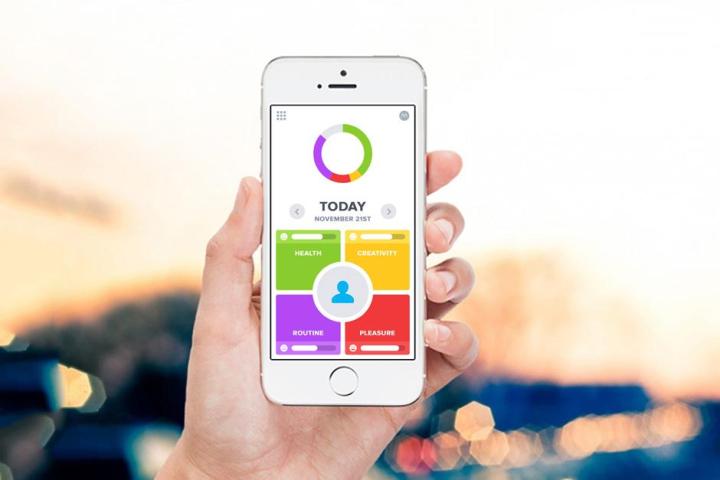
What percent of your day would you say is wasted? How often to do you arrive at the end of your night and think, “I squeezed every last second of this day?” We all are guilty of killing time, and honestly, it isn’t always our fault. Sure, you didn’t have to watch that YouTube video of a penguin falling into a hole in the ice, but you did. And then you watched it half a dozen more times.
OptimizeMe isn’t about cutting that YouTube video out of your life entirely, it’s just about making sure it’s not getting in the way of more important things. It’s designed to find the time in your day that you aren’t using efficiently and pointing you to more productive ways to spend it. That’s a change we could all use. The only problem is, OptimizeMe can occasionally occupy some of that time itself.
The app is an activity log, designed to keep track of everything that you do over the course of a day. Fair warning, though. It requires a lot of commitment from us just to get anything out of it. We not only had to be proactive about logging our life, but also had to do it honestly so OptimizeMe and its life coach robot, Ari, could judge us properly. Being honest, even with a fake robot, isn’t easy.
If the goal of OptmizeMe is to change the structure of your day … mission accomplished. We had to change our entire daily routine to use it. Every task takes longer because you have to find it and add that you’ve done it in OptimizeMe’s activities lists. Getting up in the morning, showering, taking a coffee break – these all have to be logged, along with everything else you do. When you start them, you literally hit a timer in the OptimizeMe app and it times you.
The app runs in the background until the Record button is hit, indicating the action is done and ready to be submitted into the app’s algorithm to be analyzed. Depending on what you were recording, you’ll also have to apply modifiers that relate to your mood and how intense or productive the activity was. We added some extra “enjoyment” to good workouts and marked how productive each day of work was for us. You can also tag people and places that may be relevant to the activity to further enrich the information.
It’s all about the info. Every part of your day is split into four categories: Health, pleasure, creativity, and routine. If anything you do during the day isn’t listed in one of these, you can browse for it or add it yourself so you can better keep track of your day. For activities where you move – exercising as well as tracking steps throughout the day – the process can be streamlined by downloading Moves. This will save you on those occasions that you forget to check in with OptimizeMe before going for a run or hitting the gym. Unfortunately there is no equivalent app that can tell when you’re sitting like a slob in front of the TV or computer, so you’ll have to mark that data yourself.
Over the course of our daily activity tracking we noticed times in our day where we could be doing more. Just going through the process of logging information into OptimizeMe draws attention to how we spent our time. We wondered if we really needed to spend an hour on YouTube once we saw it logged. Was that penguin really so hilarious?
Things got more interesting the longer we used the app. That’s when the floating head of Ari started to point out trends and correlations within our day-to-day life to help us better understand our patterns and mood. It used our logged activity and the modifiers we applied to point to interesting links between parts of our day. We learned the days we had a good workout led to more productive work. Days we ate dinner later affected our sleep cycle. They aren’t groundbreaking observations, but OptimizeMe has a perspective that we don’t. It speaks this information through Ari, and puts it in an easy-to-digest form with life graphs and pie charts to hammer home the evidence.
The real problem we had with OptimizeMe is that it’s only as good as you make it. If you aren’t regularly inputting activity into it, it’s never going to serve any purpose. It’s daunting to log every part of your day … day after day. There is no category in the app for time spent entering data, but there should be. Still, in the long run, the time it takes to log information using OptimizeMe pales in comparison to the amount of time it can save you by pointing you toward more productive and positive things. We suggest trying it for a week to figure out where you can most improve. If you’re like us, you probably won’t have patience for much more than that. If you take a couple improvements to your routine from it, it’s worth the time.
Download OptimizeMe for free from the iPhone/iPad App Store. (Moves, which links with OptimizeMe, is available for $3.)
Editors' Recommendations
- Everything you need to know about the massive Apple App Store outage
- Is Temu legit? Everything you need to know about the shopping app
- Photographic Styles is the most underrated iPhone 14 camera feature you’re not using
- Sunbird looks like the iMessage for Android app you’ve been waiting for
- iOS 16: Everything you need to know about 2022’s big iPhone update













